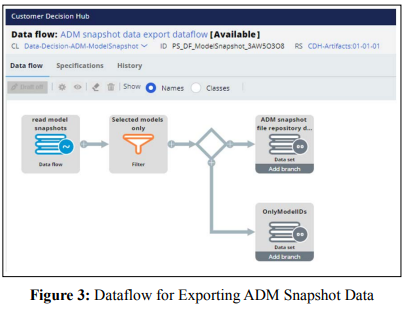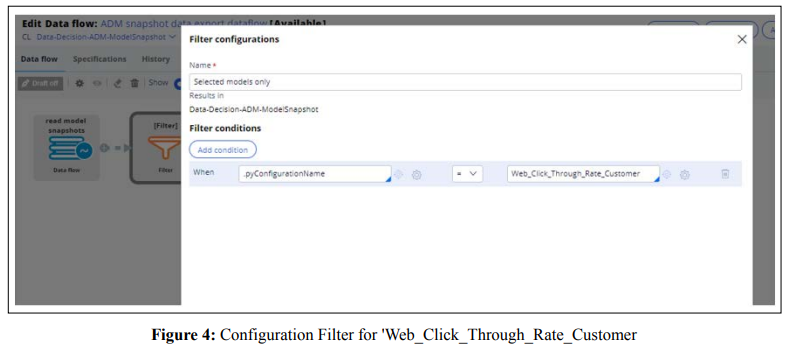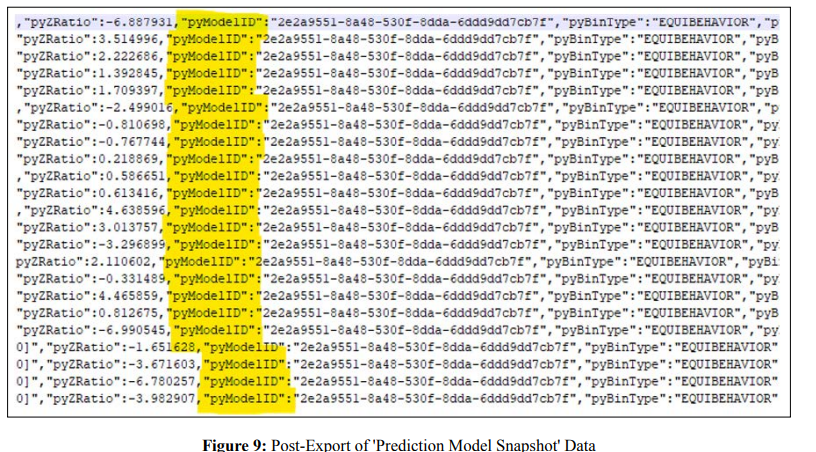Author(s): Praveen Kumar Tammana
This paper delves into the intricate process of exporting data from Pega's adaptive models, pivotal in the realm of Pega's next-best-action decision strategies for personalized customer engagement. Focusing on the Adaptive Decision Manager (ADM) within Pega Decision Management, the paper elucidates how ADM utilizes customer data, including profiles, interaction contexts, and past behaviors, to predict customer actions like web banner clicks. The adaptive models, leveraging a Bayesian algorithm, continuously learn from customer responses, adapting to changing preferences and needs. The process of exporting this dynamic, self-learning data for external analysis is critically examined. This includes the recording of historical data, managing data sets for relevant information, and the utilization of tools like Pega Data Scientist Tools for deeper insights. The paper aims to offer a comprehensive guide on harnessing these advanced predictive models for external analytical purposes, thereby enhancing decision-making and strategic planning in business environments.
This paper presents a detailed exploration of exporting data from Pega Systems' adaptive models for external analysis. It aims to elucidate the process and significance of this export, highlighting how it can transform decision-making and customer engagement strategies in businesses using Pega's advanced analytics tools.
Pega Systems is renowned for its expertise in customer relationship management (CRM) and business process management (BPM). Its platforms leverage advanced analytics to drive decision-making and optimize customer interactions. Pega's technology is distinguished by its ability to adapt to changing business environments and customer needs, making it a pivotal tool for organizations aiming to stay at the forefront of digital transformation.
Adaptive models in Pega are integral to its next-best-action decision strategies. These models predict customer propensities for various actions, enabling personalized engagement. They are self-learning, evolving with each customer interaction to refine predictions and recommendations. Pega Adaptive Decision Manager (ADM) forms the core of this functionality, allowing data scientists to create, train, and manage these models efficiently


For offline analysis of the adaptive model data, they can export the data from the Adaptive Decision Manager data mart. Two database tables contain the required monitoring information, and these tables populate two data sets.
It contains snapshots that include the model ID, the model name, the configuration name, and model attributes such as the number of predictors, the model performance, and many others.
It contains snapshots of the binning of individual predictors. The data sets have the Model ID key in common.
Exporting data from Pega's adaptive models is critical for in-depth external analysis, offering insights beyond Pega's native capabilities. This process allows businesses to perform comprehensive analytics using specialized tools, facilitating a deeper understanding of customer behavior and model performance. Exporting data is essential for validating model assumptions, detecting concept drift, and customizing models to align with specific business objectives, thereby enhancing overall decision-making and strategic planning
The methodology of the paper revolves around a comprehensive analysis of Pega's adaptive model data export process. It involves an in-depth examination of Pega's data structure and the various mechanisms available for data export. The approach includes reviewing technical documentation, extracting insights from case studies, and consulting expert opinions in the field. This methodology ensures a thorough understanding of how data export from Pega's adaptive models can be effectively utilized for external analysis.
Pega's data structure in adaptive models is sophisticated, designed to capture a wide array of customer-related information. This includes customer profiles, interaction contexts, past behaviors, and model scores. These models are dynamic, continuously updated based on customer interactions. The structure is designed to support complex decision strategies, where data is aggregated and processed to predict customer behavior, such as the likelihood of clicking a web banner. The nuanced structure of Pega's data is key to the effectiveness of its predictive analytics and personalization capabilities.
Pega provides several mechanisms for exporting data from its adaptive models. This includes built-in tools within the Pega platform, such as Prediction Studio, and the use of APIs for more customized exports. These tools enable the extraction of historical data (predictors and outcomes) for offline analysis or to build models using external machine learning services. The export process is designed to ensure data integrity and compatibility with external analytical tools, allowing data scientists to analyze and utilize this data effectively in diverse analytical environments.
The screenshots below show how to configure and export ADM snapshot data and ADM predictor data.






When exporting data from Pega’s adaptive models, best practices involve a meticulous approach to ensure accuracy and utility of the exported data. This includes a thorough understanding of the data structure and the specific requirements of the external analysis tools. Regular audits and validations are recommended to maintain the integrity and relevance of the data. Additionally, adhering to a structured export protocol helps in managing large data sets efficiently and ensures that the export process aligns with the specific analytical objectives of the external analysis.
Data integrity and security are paramount in the export process. It is crucial to implement robust encryption and secure transfer protocols to protect data during export. Regular data integrity checks are recommended to ensure that the exported data accurately reflects the source data in Pega’s adaptive models. Compliance with data privacy regulations like GDPR and HIPAA is essential, particularly when handling sensitive customer information. This includes anonymizing personal identifiers and implementing access controls to safeguard data privacy
To ensure data completeness, it is vital to have a comprehensive export plan that includes all relevant data points. This involves a clear understanding of the adaptive models and the decision strategies they inform. Regular synchronization between the Pega platform and the external analysis tools is necessary to ensure that the latest data is captured. Additionally, a mechanism should be in place to check for and rectify any data gaps or inconsistencies that may arise during the export process.
Choosing the right format for data export is crucial for compatibility with external analysis tools. Common formats like CSV, JSON, or XML should be considered based on the requirements of the analytical tools being used. It is important to ensure that the exported data maintains its structural integrity and semantic meaning when converted into these formats. Additionally, consideration should be given to the scalability of the format, especially when dealing with large datasets, to ensure efficient processing and analysis in the external systems.
The external analysis of exported data from Pega’s adaptive models involves utilizing advanced analytical tools to extract deeper insights. This process is crucial for understanding complex customer behaviors and refining decision strategies. The analysis typically focuses on trends, patterns, and anomalies in customer interactions and model predictions. It involves a detailed examination of the factors influencing customer decisions and the effectiveness of different predictive models. This external analysis allows businesses to tailor their strategies more effectively to customer needs and preferences, and to identify areas for improvement in their predictive modeling.
A variety of analytical tools and techniques are employed for analyzing exported data from Pega. These include statistical software like R and Python for advanced data processing and analytics, and visualization tools like Tableau or Power BI for creating intuitive data representations. Machine learning algorithms are often applied to uncover deeper patterns and predict future trends. Techniques such as regression analysis, clustering, and decision tree analysis are commonly used. The choice of tools and techniques largely depends on the specific objectives of the analysis, such as enhancing customer engagement or improving predictive accuracy
Deriving insights from exported data involves translating the complex data sets into actionable business intelligence. This process includes identifying key performance indicators, customer behavior trends, and efficacy of decision strategies. Insights can reveal customer preferences, predict future behavior, and highlight the effectiveness of different interaction strategies. The goal is touse these insights to inform strategic decisions, optimize customer engagement, and enhance overall business performance. Effective data interpretation requires not only technical expertise but also a deep understanding of the business context and the objectives of the analysis.
Case studies in the context of exporting and analyzing Pega's adaptive model data can provide real-world examples of how businesses have successfully leveraged this data. These case studies typically detail the business challenge, the implementation of Pega’s adaptive models, the process of data export and analysis, and the outcomes achieved. They might include examples of improved customer engagement strategies, enhanced predictive accuracy, or increased operational efficiency. These case studies serve as valuable learning tools, demonstrating practical applications and best practices in utilizing exported data from Pega’s adaptive models for external analysis.
The process of exporting and analyzing data from Pega’s adaptive models presents several challenges and considerations. Key among these is ensuring the accuracy and relevancy of the data in the context of rapidly changing customer behaviors and market conditions. Another consideration is the complexity of the models and the need for specialized knowledge to interpret the data effectively. Businesses must also navigate the balance between gaining deep insights and respecting privacy and regulatory constraints. These challenges require a strategic approach to data management and analysis, emphasizing both technical and ethical considerations.
Managing large data sets exported from Pega’s adaptive models is a significant challenge. These data sets can be voluminous and complex, requiring robust data processing and storage capabilities. Effective handling involves implementing scalable data infrastructure and using efficient data processing techniques. There is also a need for sophisticated algorithms to analyze these large data sets without compromising on speed or accuracy. Strategies like data sampling, segmentation, and parallel processing can be employed to manage the size and complexity of the data effectively
Data privacy and compliance are critical considerations when exporting data from Pega’s adaptive models. Businesses must adhere to various data protection regulations, such as GDPR and HIPAA, which dictate how customer data can be used and stored. This involves ensuring that the data is anonymized and secure, and that customers' privacy preferences are respected. Regular audits and compliance checks are essential to maintain trust and avoid legal repercussions. Clear policies and procedures should be established to govern data handling and ensure that all privacy and compliance requirements are consistently met.
Integrating exported data from Pega’s adaptive models with external analysis tools can present several challenges. Compatibility issues may arise due to differing data formats or structures. Ensuring seamless data flow and integration requires careful planning and often custom configuration. There might also be challenges related to maintaining the integrity and quality of the data during the integration process. Addressing these challenges requires a thorough understanding of both Pega’s systems and the external tools, as well as careful mapping and transformation of data to ensure effective integration.
The paper concludes by synthesizing the findings from the detailed examination of exporting Pega’s adaptive model data for external analysis. It encapsulates the methodologies, best practices, challenges, and considerations involved in this process, emphasizing the significance of such exports in enhancing business strategies and customer engagement through data-driven insights [1-7].
Key points include the critical role of Pega’s adaptive models in predicting customer behavior and enhancing decision strategies, the complexities and nuances of Pega's data structure, the various mechanisms available for data export, and the importance of maintaining data integrity and security. The analysis highlights the challenges in handling large data sets, ensuring privacy and compliance, and integrating exported data with external tools. Best practices for exporting data and deriving valuable insights are also discussed.
Future trends in exporting data from Pega’s adaptive models may include advancements in data processing and analytics technologies, further integration of AI and machine learning for deeper insights, and evolving data privacy regulations impacting data management practices. The trend towards more personalized customer engagement strategies will likely continue, driving the need for more sophisticated data analysis tools and techniques.
The final thoughts emphasize the growing importance of datadriven decision-making in business. The ability to export and analyze data from advanced systems like Pega's adaptive models is becoming increasingly crucial for businesses seeking to stay competitive and responsive to customer needs. The paper underscores the need for continuous adaptation and improvement in data analysis methodologies to fully leverage the potential of such rich data sources.
